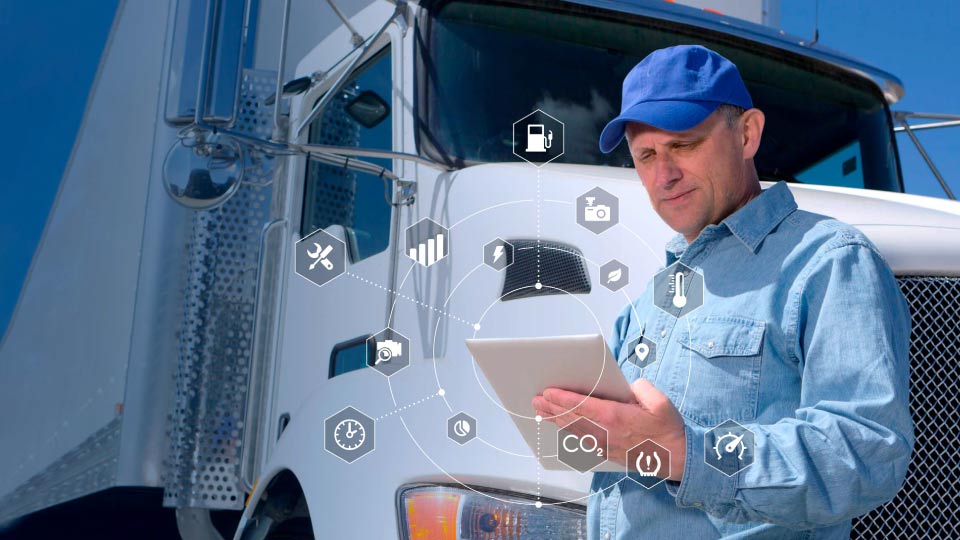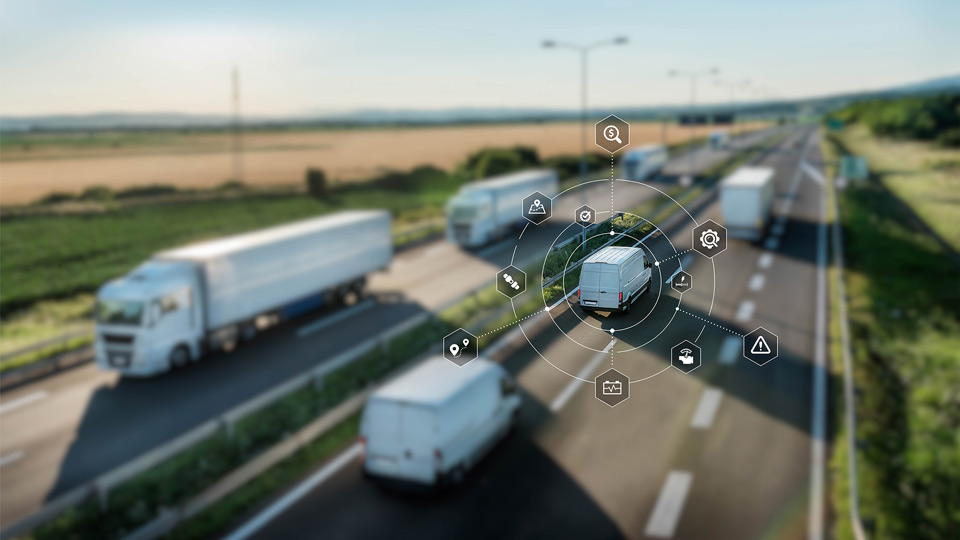
Addressing the barriers to EV adoption

Table of Contents
Introduction
Electric vehicles promise increased energy security by reducing foreign fuel dependence, decreasing greenhouse gas (GHG) emissions, stimulating economic growth through development of new technologies and industries, and public health by improving local air quality.
However, there are substantial technical, social, and economic barriers to widespread adoption of electric vehicles, including vehicle costs, lower driving ranges, long charging times, and the need for charging infrastructure. In addition, people who are unfamiliar with electric vehicles are uncertain about their costs and benefits, and have diverse needs that current electric vehicles might not meet.
What are the common barriers to electric vehicle adoption?
The Geotab Energy team interviewed electric vehicle drivers to understand the challenges they faced as early adopters. This report describes the barriers to EVs and how electric utilities can help overcome them and promote clean transportation.
Opportunities for electric utilities
Regardless of what type of business you’re in, you always need to prepare for change. Electric vehicles are a significant change that utility companies have to deal with — with the potential to be either a great asset or a liability. New long-range battery electric vehicles (BEVs) can consume up to 100 kW to fully charge, more than triple the average daily energy consumption of a household in the United States (28.5 kWh).
Electric vehicle adoption continues to increase, and if left unmanaged, EV charging loads can result in increased distribution costs, as well as forcing utilities to replace existing infrastructure ahead of planned cycles. However, if EV charging is managed properly, that additional load can be an asset to the utility by shifting it to align with overgeneration or renewable energy to maximize profitability and efficiency.
When it comes to defining the value of additional load from EVs, it should be broken down into two components: the benefits from understanding and managing electric vehicle charging load, and the risks from not managing charging load.
Electric vehicle market growth
Electric vehicle adoption continues to grow, with forecasts predicting that EVs will represent 57% of all new passenger-vehicle sales by 2040. The single largest barrier to electric vehicle adoption has typically been battery cost. However, advancements in battery technology have increased energy density and cost savings from supply-chain efficiencies have helped minimize this concern. Purchasing an electric vehicle is now more accessible to a wider market of consumers.
The electric vehicle market continued to expand in 2019 with notable announcements such as Amazon’s order of 100,000 Rivian-built vans, as well as new vehicle announcements, including the Ford Mustang Mach-E, Ford F-150 and Tesla Cybertruck.
One change that should be of interest to utilities was the shift in market share. In 2018, long-range BEVs, which include vehicles with a battery capacity of 50 kWh or greater, made up 58% of all EVs sold in the U.S. Despite segment growth, electric vehicles only represent approximately 1% of all new car sales.
Electric utilities can play a significant role in increasing the rate of electric vehicle adoption.
To do this, it is critical to understand regional factors such as:
- How many electric vehicles are connecting to the grid?
- What is the subsequent impact of charging load?
- What are the local barriers to electric vehicle adoption?
- Who are electric vehicle drivers?
Communicating with their existing customers to promote the adoption of electric vehicles, utilities can help build a more resilient and reliable grid at the same time.
Existing barriers to widespread electric vehicle adoption
Consumer education
Electric vehicles are still a relatively new technology. Although early adopters have paved the way, many mainstream consumers are unaware or just learning about the advantages of electric vehicles. Misconceptions about EVs are still common. Electric vehicles will change the way we use personal transportation and the average consumer will need help and time to understand what is changing and what will stay the same.
Early adopters of electric vehicles often understand what they want to purchase before visiting a dealership. However, mass market consumers who simply want a vehicle may not be as informed. Vehicle dealers who are incentivized to sell vehicles, rather than electric vehicles, naturally choose the path of least resistance and guide customers towards purchasing what they know they can sell: gas powered vehicles.
Electric utilities have an opportunity to lead in educating future EV owners. Utilities are a natural fit for EV education as they are already communicating with potential drivers, they have a vested interest in increased adoption, and will continue to be a part of an EV driver’s journey once they have purchased the vehicle.
Helpful resources
Electric vehicle information and advocacy groups:
Examples of utility-led EV messaging:
- Con Ed – Electric Vehicles
- TVA – Electric Vehicles
- Consumers Energy – Electric Vehicles
- Georgia Power – Electric Vehicles
- Tacoma Public Utilities – Electric Vehicles
Range anxiety: the fear of running out of electricity
The second most commonly cited barrier to EV adoption is a perceived drawback due to range. The fear of running out of electricity, also called “range anxiety,” is a concern of many prospective EV owners.
However, if you speak to your average EV owner it is not as much of a concern as it once was. Previously, a BEV like the Nissan Leaf would have a rough range of 80 miles (130 km) and this would be reduced if energy were used for things like heating the cabin. Currently, long range BEVs, such as the Tesla Model 3 and Chevrolet Bolt, have an estimated range of over 200 miles (320 km). This is significantly larger than the average daily driving distance, even if you take into consideration range reductions.
So the question remains, is this fear still justified or is it a misconception? The “2020 Deloitte Global Automotive Consumer Study” mentions that even though drivers only drove 27 miles (45 km) on average per day, over 60% said they would like their fully-electric vehicle to have a minimum range of 200 to 400 miles (320 to 640 km). Range anxiety may be a matter of drivers commonly over-estimating daily driving distance.
That being said, there are practical reasons why potential electric vehicle drivers should be concerned about range. Drivers may not have access to dedicated charging infrastructure either at work or at home, as in apartments or condominiums. As well, they may use their EV for weekend or long-distance trips, either for work or personal life.
Quick reference for electric vehicle models by range:
Public charging station ease-of-use
The reliability of charging infrastructure is another hurdle to overcome when it comes to electric vehicle adoption. While long-trips in fuel vehicles are common and reliable in that refueling is easy and commonly available en route. The same trip for an electric vehicle driver requires researching the location of charging stations along the way, and setting aside time to recharge.
During our interviews, we found that for early adopters, public charging presented several issues:
- Duration of charging — Even fast charging stations have significantly longer charging times compared to fuel pump refill times for internal combustion powered vehicles.
- Poor user experience
- Availability of public charging stations — Either the station was already in use or not operational.
Drivers also noted having to plan their stops beforehand when embarking on longer distance trips. They used this time to stop for a meal, stretch and use available facilities. This, however, wasn’t the primary concern with public charging stations.
Who is responsible for ensuring the availability, and proper operation of public charging infrastructure? Survey results from the 2020 Deloitte Global Automotive Consumer Study demonstrated that there is no firm consensus in the U.S. on who should be responsible for building and maintaining public electric vehicle charging stations. Approximately one third of respondents chose vehicle manufacturers as the entity who should build and maintain charging infrastructure. This, however, is undoubtedly influenced by Tesla’s popularity and role in building charging corridors. Other responses were fairly evenly distributed between government, fuel companies and electric utilities.
Public charging station maps:
Initial capital cost of electric vehicles
A major barrier to adoption is simply the purchase price, which even with rebates accounted for is typically higher than its internal combustion engine counterpart. Although there are many cost-saving factors related to vehicle ownership which support a case for cost parity and cost savings over the lifetime of vehicle ownership, the initial capital cost is difficult to overcome for many consumers. And simply, sticker-shock scares mass market consumers away from considering an electric vehicle.
EVs are still simply considered a luxury item by many. Although, with the continuing drop in battery prices thanks to advancements in technology and production efficiencies, we are getting closer to price parity. In August 2018, Reinhard Fischer, a senior exec at VW, stated, “We strongly believe that the tipping point is near, and that tipping point will be price equity.”
When will we reach price parity?
In a 2019 report from the International Council on Clean Transportation titled, “Update on electric vehicle costs in the United States through 2030,” the cost parity is estimated to arrive between 2022 and 2024 for passenger cars followed by crossover and sport utility vehicles between 2023 and 2025.
Despite states and the federal government amplifying efforts to incentivize the use of renewable energies, these incentives occur at purchase or installation and come in the form of a rebate or tax credit, oftentimes not much more than $7,500.
Utility prices, consequently, are not affected by such policies, which makes charging more expensive and has long served as a disincentive for the use of EVs. However, with credits, rebates, and off-peak, time-of-use rates increasingly common, utilities have taken it upon themselves to ease this burden and propel the rise of EVs in their coverage zones.
Some utility companies like Pepco, Georgia Power, the Orlando Utilities Commission, and the Los Angeles Department of Water and Power have offered incentives for years and, thus, serve as prominent archetypes for subsequent plans. Indeed, this success has propelled the number of utility companies offering incentives for EVs to grow in recent years.
There are now 44 utility companies in the U.S. offering discounted rates, rebates, or other incentives for EV implementation, an impressive increase over the 28 companies offering such programs in 2015. Furthermore, there are more than 200 utility companies which offer time-of-use rates serving similar incentivizing purposes and making intelligent charging of EVs more affordable and efficient.
The growth of these incentive programs has been due to the success thereof and the clear willingness on behalf of consumers to benefit from the technological and financial benefits on offer. In addition to time-of-use or off-peak plans, which offer lower rates for charging during times of decreased demand, there has been remarkable progress made in credits or rebates which incentivize consumers to invest in EV technology and emphasize the short- and long-term benefits.
For example, one of California’s leading utility companies, Southern California Edison has started to offer a $450 rebate for the purchase of EVs or PHEVs on top of the existing off-peak rate plan. Similarly, ConEdison offers an incentive program, SmartCharge NewYork powered by Geotab Energy which provides owners up to $400 for off-peak EV charging.
While off-peak charging by electric vehicles could help reduce rates for all utility customers as well as costs for the utility companies themselves, rebates and credits available from utilities in California and Minnesota, for instance, ease the transition for consumers into the EV marketplace and ensure optimal utilization of the special rate plans available.
Examples of utility-led electric vehicle rebate programs:
Access to charging stations in multi-unit residential
An additional barrier to electric vehicle adoption exists for those who live in apartments, condos or rely on street parking, that is access to electric vehicle charging stations. Unlike residential customers with private parking, current or potential electric vehicle drivers who live in multi-unit dwellings typically do not have the option to independently install charging infrastructure. As a result for this segment of drivers, choosing an electric vehicle is not an easy option.
As electric vehicles become more widely adopted, local governments, building owners, property managers and condo boards are starting to confront these challenges. Existing structures are not designed to support charging stations. Smaller structures may not have any electricity, or there may not be any covered structure at all. If there is electrical infrastructure in place, it may not be able to support the increased load. Some municipalities are requiring that all new structures be built with this framework in place, in order to avoid higher retrofitting costs in the future.
Installing charging stations is expensive and not every parking space needs a charger, but how can they ensure there is a charger in the right spots? There are often assigned parking spaces, but tenants change and a new tenant may or may not have an EV. The reassignment of parking spaces is not an easy task, and in some cases parking is deeded to the condo, making this near-impossible. On top of this there could also be zoning permits or even historical building permits that need to be obtained.
The installation of charging stations is one of the hurdles, there is also the issue of metering and paying for the electricity. Unless there are individual submeters at each station, which adds to the expense, there is no clear way to bill the EV owner. Another concern would be that without some form of identity verification, such as a swipe card, someone else could use the station at the EV owners expense.
A different approach would be for the building owners to offer charging at no cost for the EV owner, however there are a number of objections with this option. Property managers wouldn’t want to just absorb these costs, which means the expense would be passed on to the owners / renters. This is not ideal either as it means people who don’t drive EVs are subsidizing the costs for those who do.
Learn more about charging for multi-unit residential buildings in this article: Challenges EV owners face when they live in a MURB or MDU
How to motivate drivers to go electric
The Geotab Energy team asked EV owners about what motivated them to purchase an electric vehicle. Motivating factors included:
- Environmental reasons (38%)
- Interest in new technology (31%)
- Operational cost savings (19%)
- Other
In the Deloitte 2020 Global Automotive Consumer Study, responses to this question were similar: lower emissions, lower vehicle operating costs, social status/keeping up with the latest technology and others. The results showed that environmental reasons were still the driving factor (47%), lower operating costs (38%), and only 5% replied tech/social status.
It is no surprise that the number one response cited environmental concerns. As a result, there is an increase in awareness and more demand for eco-friendly technology, which is the next major factor. Today’s electric vehicles are far superior to earlier models, they are becoming more affordable and there is more supportive infrastructure. These factors mean they will appeal more to the general public than “early adopters,” which explains the shift in priorities of recent first-time EV buyers.
More links and resources:
- Motivating and educating an electric vehicle owner
- Deloitte – 2020 Global Automotive Consumer Study
- Drive Electric US – Convenience of EV ownership
The role of electric utilities in promoting electric vehicle adoption
Electric utility companies have a lot to gain by promoting electric vehicle adoption in regard to customer satisfaction, grid reliability, system economics and revenue generation. They are currently in the unique position of providing expanded services to an emerging segment of consumers as well as increasing the delivery of energy to existing customers.
The new service offering could include energy rates designed for electric vehicle owners or commercial businesses with public charging stations. As well, the new service provides a channel for utilities to communicate with and grow advocacy among engaged and supportive customers. In return, electric utilities win by increasing supply to existing customers, gaining loyalty from others and accessing flexible grid assets in the form of electric vehicle batteries which can be controlled and influenced to shift load off-peak or align with renewables.
Electric vehicle adoption continues to grow and soon they will become a cornerstone of the grid. If managed properly, their load will be an incredibly valuable asset as it can help support clean energy initiatives while boosting profitability. If left unmanaged, it will result in higher distribution costs and expensive infrastructural repairs.
The utility industry is quantifying the value of managing electric vehicle charging load across systems and local grids. Some progressive utilities are leading the way in transportation, sustainability, demand management, demand response and distributed energy resource innovation. For these utilities, the vision of integrating electric vehicles with the grid will provide new revenue streams, cost savings and increased services for organizations undergoing transformational change.
Post Tags
About Geotab
Geotab is a global leader in connected vehicle and asset solutions, empowering fleet efficiency and management. We leverage advanced data analytics and AI to transform fleet performance, safety, and sustainability, reducing cost and driving efficiency. Backed by top data scientists and engineers, we serve over 55,000 global customers, processing 80 billion data points daily from more than 4.7 million vehicle subscriptions. Geotab is trusted by Fortune 500 organizations, mid-sized fleets, and the largest public sector fleets in the world, including the US Federal Government. Committed to data security and privacy, we hold FIPS 140-3 and FedRAMP authorizations. Our open platform, ecosystem of outstanding partners, and Marketplace deliver hundreds of fleet-ready third-party solutions. This year, we're celebrating 25 years of innovation. Learn more at www.geotab.com and follow us on LinkedIn or visit Geotab News and Views.
© 2025 Geotab Inc.All Rights Reserved.
This white paper is intended to provide information and encourage discussion on topics of interest to the telematics community. Geotab is not providing technical, professional or legal advice through this white paper. While every effort has been made to ensure that the information in this white paper is timely and accurate, errors and omissions may occur, and the information presented here may become out-of-date with the passage of time.
Recent News

4 ways to unlock the power of quality data
June 30, 2023


Your comprehensive guide to the Canadian ELD mandate
May 16, 2022

Putting fleet data quality to the test for risk management
March 25, 2022